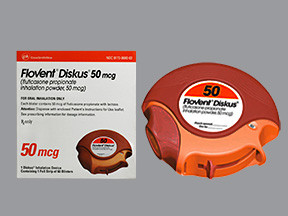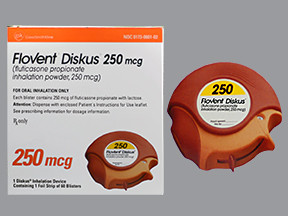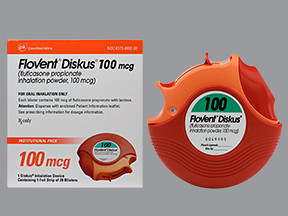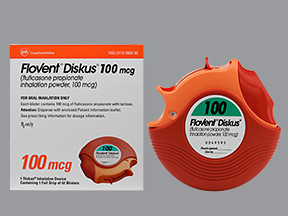FLUTICASONE DISK INHALER - ORAL
PHONETIC PRONUNCIATION: (floo-TIK-a-sone)
COMMON BRAND NAME(S): Flovent Rotadisk
GENERIC NAME(S): fluticasone propionate
Uses
USES: Fluticasone is used to control and prevent symptoms (such as wheezing and shortness of breath) caused by asthma. It works by reducing swelling (inflammation) of the airways in the lungs to make breathing easier. Controlling symptoms of asthma helps you maintain your normal activities and decreases time lost from work or school. Fluticasone belongs to a class of drugs known as corticosteroids. This medication must be used regularly to be effective. It does not work right away and should not be used to relieve sudden asthma attacks. If an asthma attack occurs, use your quick-relief inhaler (such as albuterol, also called salbutamol in some countries) as prescribed.
How to use FLUTICASONE DISK INHALER - ORAL
HOW TO USE: Read the Patient Information Leaflet that comes with this product before you start using fluticasone and each time you get a refill. Read the patient instructions on how to use this inhaler properly. If you have any questions, ask your doctor or pharmacist. Hold this device in a level, flat position. Inhale this medication by mouth as directed by your doctor, usually twice a day (in the morning and evening). The dosage is based on your medical condition and response to treatment. It is important to inhale each dose deeply to get the right amount of drug into your lungs. You may or may not taste/feel the drug when you inhale. Either is normal. Do not breathe out (exhale) into the inhaler device. If two inhalations are prescribed, wait at least one minute between them. If you are using other inhalers at the same time, wait at least 1 minute between the use of each medication, and use this drug (the corticosteroid) last. Gargle and rinse your mouth with water after each use to help prevent irritation and fungal/yeast infections (thrush) in the mouth and throat. Do not swallow the rinse water. Do not take the inhaler apart or wash the mouthpiece or any part of the device. Close the device after each use. Use this medication regularly to get the most benefit from it. This medication works best if used at evenly spaced intervals. To help you remember, use it at the same times each day. Do not increase your dose, use this medication more often, or stop using it without first consulting your doctor. If you are regularly using a different corticosteroid taken by mouth (such as prednisone), you should not stop using it unless directed by your doctor. You may have withdrawal symptoms if the drug is suddenly stopped. Some conditions (such as asthma, allergies) may become worse when the drug is suddenly stopped. To prevent withdrawal symptoms (such as weakness, weight loss, nausea, muscle pain, headache, tiredness, dizziness), your doctor may direct you to slowly lower the dose of your old medication after you begin using this product. Consult your doctor or pharmacist for more details, and report any withdrawal reactions right away. See also Precautions section. It may take up to 2 weeks or longer before the full benefit of this drug takes effect. Tell your doctor if your condition does not improve or if it worsens. Learn which of your inhalers you should use every day (controller drugs) and which you should use if your breathing suddenly worsens (quick-relief drugs). Ask your doctor ahead of time what you should do if you have new or worsening cough or shortness of breath, wheezing, increased sputum, worsening peak flow meter readings, waking up at night with trouble breathing, if you use your quick-relief inhaler more often (more than 2 days a week), or if your quick-relief inhaler does not seem to be working well. Learn when you can treat sudden breathing problems by yourself and when you must get medical help right away.
Side Effects
Precautions
Interactions
Overdose
Images
Reviews
Faq for FLUTICASONE DISK INHALER - ORAL
Fluticasone disk inhaler is used to prevent and control symptoms of asthma, such as wheezing and shortness of breath. It is also used to treat certain lung diseases, such as chronic obstructive pulmonary disease (COPD) and bronchitis.
Fluticasone disk inhaler belongs to a class of drugs called corticosteroids. It works by reducing inflammation in the lungs, which helps to relax and open up the airways, making it easier to breathe.
It is important to consult with your doctor before using fluticasone disk inhaler during pregnancy or while breastfeeding. Your doctor can assess the potential risks and benefits and make a suitable recommendation.
Common side effects of fluticasone disk inhaler may include headache, sore throat, hoarseness, cough, and nasal congestion. However, serious side effects are rare. If you experience any unusual or severe side effects, contact your doctor immediately.
The dosing instructions for fluticasone disk inhaler may vary depending on the individual and the specific condition being treated. It is typically recommended to use the inhaler once or twice daily, as directed by your doctor.
Fluticasone disk inhaler is generally safe for use in children aged 4 years and older. However, the dosage may be different for children, so it is important to follow the specific instructions provided by your doctor or pharmacist.
The effects of fluticasone disk inhaler may not be immediately noticeable. It may take several days or weeks of regular use for the medication to reach its full effectiveness. It is important to use the inhaler consistently and as prescribed for best results.
Yes, you can still use a rescue inhaler while using fluticasone disk inhaler. However, it is important to follow your doctor's instructions regarding the proper timing and use of each inhaler.
Yes, fluticasone disk inhaler is a corticosteroid medication. It is important to use it as prescribed by your doctor and not exceed the recommended dosage.
Disclaimer
IMPORTANT: HOW TO USE THIS INFORMATION: This is a summary and does NOT have all possible information about this product. This information does not assure that this product is safe, effective, or appropriate for you. This information is not individual medical advice and does not substitute for the advice of your health care professional. Always ask your health care professional for complete information about this product and your specific health needs.





No Reviews Yet